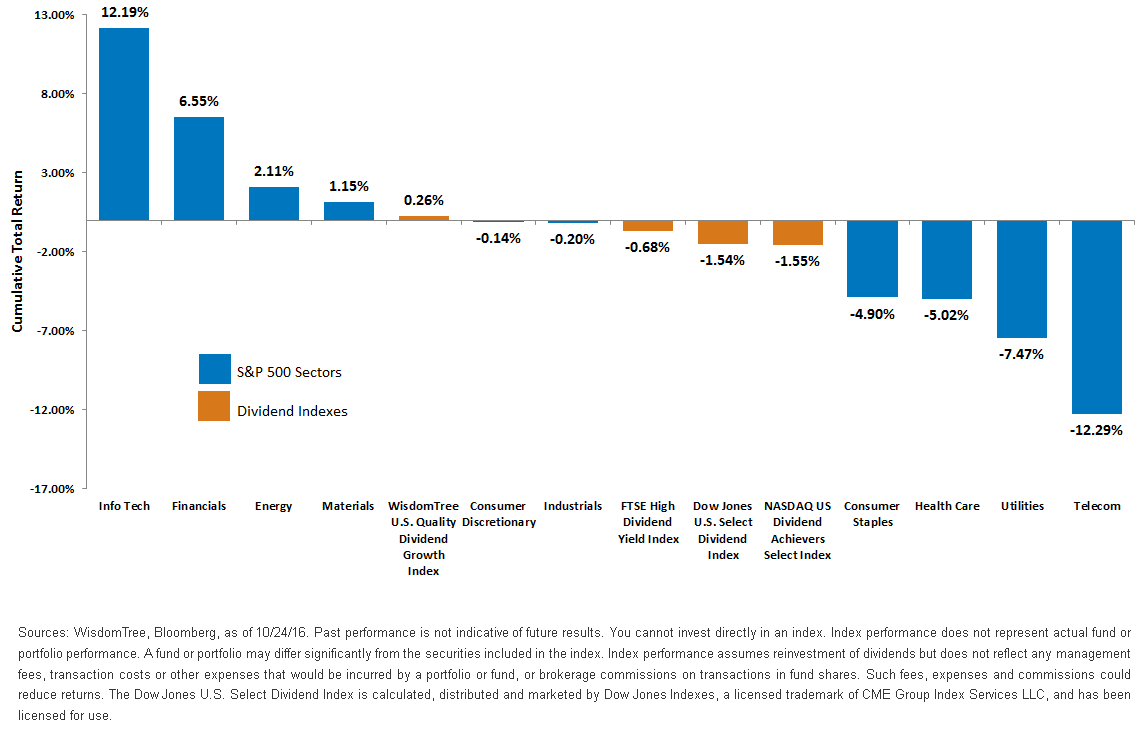Solving for Income as Rates Rise



Given the ongoing uncertainties and continued concerns surrounding economic growth, both here and abroad, investors will likely position portfolios after the November election based on where they believe interest rates will be headed in the months to come.
Two key factors in that calculation will be 1) whether the Federal Reserve Bank (Fed) decides to raise interest rates at its December meeting, and 2) whether a new administration in Washington can pass a fiscal stimulus package next year.
What are two of WisdomTree’s top ideas going into the end of the year?
Fixed Income
We believe income-based solutions should continue to be a highlighted goal for bond investors. However, it is important to consider how yield enhancement may be achieved and the potential risks that could be involved. Oftentimes, the pursuit of additional income involves placing bets too far out in duration (interest rate risk) and/or going too far down the credit ratings curve (credit risk). Given an investor’s parameters, high-yield corporates and emerging market debt could be viewed as solutions for income, but for core fixed income portfolios, these types of investments may be viewed as adding too much incremental risk.
In our opinion, a more disciplined approach that does not involve reaching for yield would be to focus on the relative value differentials that exist in the investment-grade universe—in other words, reallocating positions among the interest- and credit-sensitive arenas. In our interest rate scenarios, we believe an over-weight to Treasuries is not only suboptimal but also susceptible to any potential unexpected rise in rates. The sector of fixed income that we believe offers the best relative value is investment-grade corporates. Not only does this sector provide a visible yield advantage to Treasuries, it can also offer some risk mitigation from rising rates if the economy improves.
The WisdomTree Barclays U.S. Aggregate Bond Enhanced Yield Fund (AGGY) follows this disciplined approach and is suited to serve as an income solution, representing the core fixed income aspect of an investor’s portfolio. Its risk characteristics are well placed for a variety of interest rate landscapes and/or event risks that can come about.
Equities
On the equity front, we have seen a shift in sector leadership in the S&P 500 Index since the yield on the 10-Year Treasury bottomed at 1.36% on July 8. As interest rates have climbed back toward the 1.8% range, tech and financial stocks have rallied, while the telecom, utilities and consumer staples sectors of the S&P 500 fell behind. The negative returns in those sectors over the past few months have impacted the performance of dividend indexes, particularly those that tilt toward the higher-yielding sectors.
As we show below, the three underlying dividend indexes tracked by the three largest dividend ETFs have declined between 0.68% and 1.55% since rates have backed up. By contrast, the WisdomTree U.S. Quality Dividend Growth Index, after returning 5.2% in the first half of the year, has actually remained positive over that period, as more of its weight is tilted toward the technology sector.
July 8 to Oct 24: S&P 500 Sectors and Dividend Indexes

Going forward, we believe the dividend growers in the U.S. continue to be more attractively valued than their higher-dividend-yielding brethren. For example, as of September 30, the forward price-to-earnings (P/E) ratio on the WisdomTree U.S. Quality Dividend Growth Index was 16.9x; that is lower than the 19.2x forward P/E ratio on the Dow Jones U.S. Select Dividend Index. The ETF that tracks the WisdomTree Index, the WisdomTree U.S. Quality Dividend Growth Fund (DGRW), now has a three-year track record. Over the last year and the last three years, it has generated double-digit total returns and double-digit dividend growth.1 (For standardized performance of DGRW, click here.) Moreover, of all of WisdomTree’s U.S. Indexes, the WisdomTree U.S. Quality Dividend Growth Index has a total shareholder yield (dividend yield plus net share buyback yield) close to 6%.
Conclusion
For those looking to generate income in a rising interest rate environment, we believe investors should consider AGGY in the core of their U.S. fixed income allocations and DGRW in the large-cap or equity income portions of their portfolios.
Unless otherwise noted, data source is Bloomberg, as of September 30, 2016.
1Double-digit returns were achieved primarily during favorable market conditions. Investors should not expect that such favorable returns can be consistently achieved. A fund’s performance, especially for very short time periods, should not be the sole factor in making your investment decision.
Important Risks Related to this Article
There are risks associated with investing, including possible loss of principal. Funds focusing their investments on certain sectors increase their vulnerability to any single economic or regulatory development. This may result in greater share price volatility.Fixed income investments are subject to interest rate risk; their value will normally decline as interest rates rise. Fixed income investments are also subject to credit risk, the risk that the issuer of a bond will fail to pay interest and principal in a timely manner, or that negative perceptions of the issuer’s ability to make such payments will cause the price of that bond to decline. Investing in mortgage- and asset-backed securities involves interest rate, credit, valuation, extension and liquidity risks and the risk that payments on the underlying assets are delayed, prepaid, subordinated or defaulted on. Due to the investment strategy of these Funds, they may make higher capital gain distributions than other ETFs. Please read each Fund’s prospectus for specific details regarding each Fund’s risk profile.
Performance is historical and does not guarantee future results. Current performance may be lower or higher than quoted. Investment returns and principal value of an investment will fluctuate so that an investor’s shares, when redeemed, may be worth more or less than their original cost. Performance data for the most recent month-end is available at www.wisdomtree.com.
WisdomTree shares are bought and sold at market price (not NAV) and are not individually redeemed from the Fund. Total returns are calculated using the daily 4:00 p.m. EST net asset value (NAV). Market price returns reflect the midpoint of the bid/ask spread as of the close of trading on the exchange where Fund shares are listed. Market price returns do not represent the returns you would receive if you traded shares at other times.



